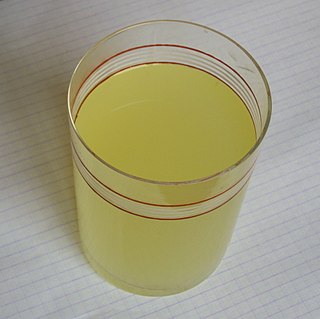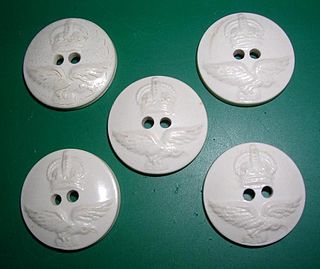Milk fiber or milk wool is a type of Azlon, a regenerated protein fiber based on the casein protein found in milk. There are several trade names for milk-casein-based fibers, including Lanital, Fibrolane and Aralac.
Contents

Milk fiber or milk wool is a type of Azlon, a regenerated protein fiber based on the casein protein found in milk. There are several trade names for milk-casein-based fibers, including Lanital, Fibrolane and Aralac.

First produced and patented in Italy in 1935 by Antonio Ferretti [1] and sold under the name Lanital, milk fiber was created under an Italian national self-sufficiency drive and was intended to capitalize on previous successes with rayon. [2] Milk fibers enjoyed a brief period of success in the 1930s and 1940s. The popularity of milk fibers declined rapidly once full-synthetic fibers were developed. Fully synthetic fibers, such as acrylic, were able to significantly undercut milk fiber on price while being more durable. [3] During the 2010s several producers tried to reintroduce milk fibers to commercial production.[ citation needed ]
The production process of milk fiber was of some public interest and was documented on film by several contemporary sources. [4] A simplified overview of the process is as follows: [5]

Milk is a white liquid food produced by the mammary glands of mammals. It is the primary source of nutrition for young mammals before they are able to digest solid food. Milk contains many nutrients, including calcium and protein, as well as lactose and saturated fat. Immune factors and immune-modulating components in milk contribute to milk immunity. Early-lactation milk, which is called colostrum, contains antibodies and immune-modulating components that strengthen the immune system against many diseases. The US CDC agency recommends that children over the age of 12 months should have two servings of dairy (milk) products a day, and more than six billion people worldwide consume milk and milk products.

Rennet is a complex set of enzymes produced in the stomachs of ruminant mammals. Chymosin, its key component, is a protease enzyme that curdles the casein in milk. In addition to chymosin, rennet contains other enzymes, such as pepsin and a lipase.

Wool is the textile fiber obtained from sheep and other mammals, especially goats, rabbits, and camelids. The term may also refer to inorganic materials, such as mineral wool and glass wool, that have some properties similar to animal wool.

Textile is an umbrella term that includes various fiber-based materials, including fibers, yarns, filaments, threads, different fabric types, etc. At first, the word "textiles" only referred to woven fabrics. However, weaving is not the only manufacturing method, and many other methods were later developed to form textile structures based on their intended use. Knitting and non-woven are other popular types of fabric manufacturing. In the contemporary world, textiles satisfy the material needs for versatile applications, from simple daily clothing to bulletproof jackets, spacesuits, and doctor's gowns.

Yarn is a long continuous length of interlocked fibres, used in sewing, crocheting, knitting, weaving, embroidery, ropemaking, and the production of textiles. Thread is a type of yarn intended for sewing by hand or machine. Modern manufactured sewing threads may be finished with wax or other lubricants to withstand the stresses involved in sewing. Embroidery threads are yarns specifically designed for needlework. Yarn can be made of a number of natural or synthetic materials, and comes in a variety of colors and thicknesses. Although yarn may be dyed different colours, most yarns are solid coloured with a uniform hue.

Casein is a family of related phosphoproteins that are commonly found in mammalian milk, comprising about 80% of the proteins in cow's milk and between 20% and 60% of the proteins in human milk. Sheep and cow milk have a higher casein content than other types of milk with human milk having a particularly low casein content.

Whey is the liquid remaining after milk has been curdled and strained. It is a byproduct of the manufacturing of cheese or casein and has several commercial uses. Sweet whey is a byproduct resulting from the manufacture of rennet types of hard cheese, like cheddar or Swiss cheese. Acid whey is a byproduct brought out during the making of acid types of dairy products, such as strained yogurt.

Cheesemaking is the craft of making cheese. The production of cheese, like many other food preservation processes, allows the nutritional and economic value of a food material, in this case milk, to be preserved in concentrated form. Cheesemaking allows the production of the cheese with diverse flavors and consistencies.

Acrylic fibers are synthetic fibers made from a polymer (polyacrylonitrile) with an average molecular weight of ~100,000, about 1900 monomer units. For a fiber to be called "acrylic" in the US, the polymer must contain at least 85% acrylonitrile monomer. Typical comonomers are vinyl acetate or methyl acrylate. DuPont created the first acrylic fibers in 1941 and trademarked them under the name Orlon. It was first developed in the mid-1940s but was not produced in large quantities until the 1950s. Strong and warm, acrylic fiber is often used for sweaters and tracksuits and as linings for boots and gloves, as well as in furnishing fabrics and carpets. It is manufactured as a filament, then cut into short staple lengths similar to wool hairs, and spun into yarn.

A milk substitute is any substance that resembles milk and can be used in the same ways as milk. Such substances may be variously known as non-dairy beverage, nut milk, grain milk, legume milk, mock milk and alternative milk.

A2 milk is a variety of cows' milk that mostly lacks a form of β-casein proteins called A1, and instead has mostly the A2 form. Cows' milk like this was brought to market by The a2 Milk Company and is sold mostly in Australia, New Zealand, China, and the United States. It was sold in the United Kingdom between 2012 and 2019. Non-cow milk, including that of humans, sheep, goats, donkeys, yaks, camels, buffalo, and others, also contain mostly A2 β-casein, and so the term "A2 milk" is also used in that context.

The production of wine often includes a process called fining, in which fining agents are added to wine to remove proteins, yeast, and other suspended organic particles, and later filtered out. Fining agents can be either animal, carbon, or clay-based. Animal-based fining agents include gelatin, isinglass, egg white (albumen), and casein.

Galalith is a synthetic plastic material manufactured by the interaction of casein and formaldehyde. The commercial name is derived from the Ancient Greek words gala and lithos. It is odourless, hard, resists humidity to a certain degree, is antistatic, also an electrical insulator and virtually nonflammable. It was produced under a plethora of other commercial names such as aladdinite, Casolith and lactoloid.

Animal fibers are natural fibers that consist largely of certain proteins. Examples include silk, hair/fur and feathers. The animal fibers used most commonly both in the manufacturing world as well as by the hand spinners are wool from domestic sheep and silk. Also very popular are alpaca fiber and mohair from Angora goats. Unusual fibers such as Angora wool from rabbits and Chiengora from dogs also exist, but are rarely used for mass production.
Azlon is a synthetic textile fiber composed of protein material derived from natural sources such as soy, peanut, milk or corn. Currently it is used in clothing.

Vegan cheese is a category of non-dairy, plant-based cheese analogues. Vegan cheeses range from soft fresh cheeses to aged and cultured hard grateable cheeses like plant-based Parmesan. The defining characteristic of vegan cheese is the exclusion of all animal products.

Sour cream is a dairy product obtained by fermenting regular cream with certain kinds of lactic acid bacteria. The bacterial culture, which is introduced either deliberately or naturally, sours and thickens the cream. Its name comes from the production of lactic acid by bacterial fermentation, which is called souring. Crème fraîche is one type of sour cream with a high fat content and less sour taste.

The a2 Milk Company Limited is a dual listed NZX and ASX 50 public listed company that commercialises intellectual property relating to A1 protein-free milk that is sold under the a2 and a2 Milk brands, as well as the milk and related products such as infant formula.
Cellular agriculture focuses on the production of agricultural products from cell cultures using a combination of biotechnology, tissue engineering, molecular biology, and synthetic biology to create and design new methods of producing proteins, fats, and tissues that would otherwise come from traditional agriculture. Most of the industry is focused on animal products such as meat, milk, and eggs, produced in cell culture rather than raising and slaughtering farmed livestock which is associated with substantial global problems of detrimental environmental impacts, animal welfare, food security and human health. Cellular agriculture is a field of the biobased economy. The most well known cellular agriculture concept is cultured meat.

A milk frother is a utensil for making milk froth, typically to be added to coffee. It aerates the milk, creating a thick but light foam. Milk frothers were introduced through the use of espresso machines that contained steamed wands that would froth steamed milk. Although created in Italy, the espresso machine and steam wands were exported internationally to other countries, and frothed milk was introduced around the world.